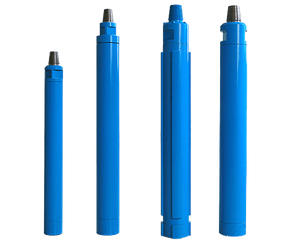How to use and maintain the down-the-hole hammer
Related products Link:
The down-the-hole hammer is an integral part of the down-the-hole drilling rig and belongs to the working device of the down-the-hole drilling rig. DTH hammers are divided into low wind pressure DTH hammers, medium wind pressure DTH hammers and high wind pressure DTH hammers.
The equipment is widely used in metallurgy, coal, chemical industry, building materials, mines and water conservancy, hydropower, highway, railway, national defense, construction and other engineering hole forming operations. Reliable performance, it is the ideal equipment for drilling blast-holes today.
The working principle of the down-the-hole hammer is as follows:
At the beginning of the impact stroke, the piston and the valve plate are in the upper position, and the compressed air enters the upper chamber of the cylinder through the radial holes of the valve cover and valve seat, pushing the piston to move downward at high speed to impact the drill bit.
When the piston travels to the liner and the spline groove is closed, the pressure in the lower chamber starts to rise, so the center hole at the upper end of the piston leaves the gas distribution rod, the upper chamber is vented to the atmosphere, the pressure drops, and the working stroke ends. When the piston hits the tail of the drill bit, the valve plate changes direction due to the pressure difference between the upper and lower parts, and the piston repeatedly returns to the stroke.
The down-the-hole hammer, like the pneumatic impact drill, is a rock drilling tool with a wide range of uses. The following is an introduction to the use and maintenance of the down-the-hole hammer.
1. Because the joints and joints of the hammer are right-handed threads, the hammer should always be kept turning right during drilling.
2. When opening a hole, the down-the-hole hammer should use small impact and propulsion force to make the drill bit enter the rock formation smoothly.
3. It is very important to match the propulsion force with the weight of the drilling tool. The thrust of the thruster must change with the weight of the drilling tool.
4. The rotation speed usually adopted by the down-the-hole hammer is generally 15-25rpm. The faster the rotation speed, the faster the cutting speed. However, in hard rock, the rotation speed should be reduced so that the drill bit does not wear too much.
5. Since both blockages and cavities may cause drill sticking, the hammer should be regularly blown and the bottom of the hole should be cleaned regularly.
6. During the rod connection process, rock ballast and various impurities will fall into the down-the-hole hammer, so the loose threaded end of the drill pipe must be covered to ensure that the drill pipe does not stick to rock ballast and dust.
7. Reasonable lubrication of the hammer can never be ignored, otherwise, it will accelerate the wear of the hammer and even cause damage.





